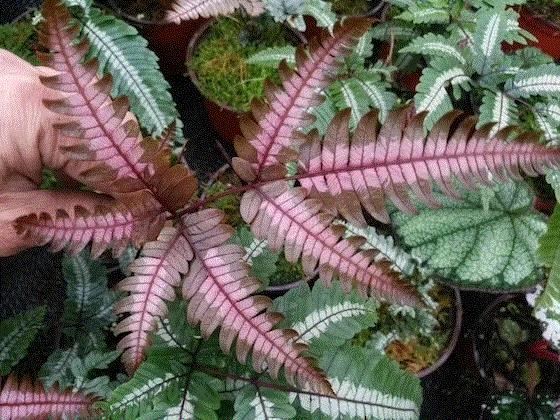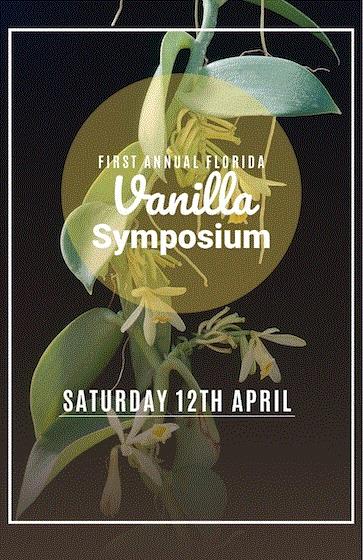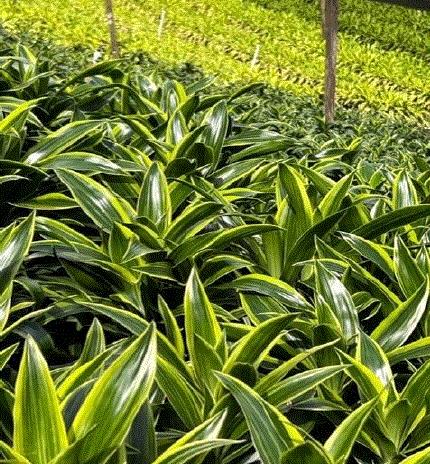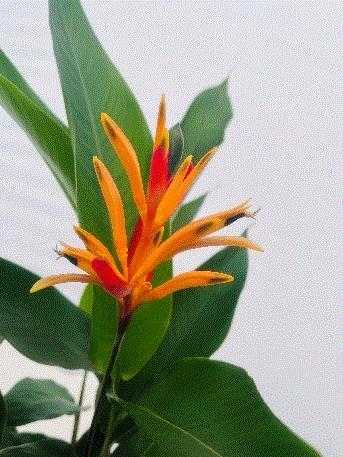Candy Stripe Pteris
I’ve written a lot about what caught my eye at the Tropical Plant International Expo (TPIE) back in January. My partner-in-writing Chris Beytes also found some stuff as he traversed the trade show floor. “Did you spot any cool plants?” I asked. And he immediately replied with the following.

This is Candy Stripe. It’s a Brake Fern (Pteris aspericaulis var. tricolor) from the folks at Casa Flora. Have you ever seen such vibrant pink new growth? It does gradually soften to a tricolored blend of green, cream and pink, but I would enjoy this pink glow as long as it lasts. This variegation is what really captured Chris’ attention.
What’s a fern doing at a tropical plant show? Because imagine this in a terrarium—it would be a stunner—or as a houseplant all on its own. I love the delicate, lace-like fronds, something you don’t get a lot of in the typical glossy green and flat houseplant world. Add the fact that this plant is easy to care for and it’s a sure bet for collectors, terrarium-makers and folks wanting to add some pink to a shade garden.
Great choice, Chris!

Florida Vanilla Symposium
Remember that vanilla orchid, Sunshine State, that won a Cool Product Award at TPIE? I’ve been in touch with the woman behind that variety, Stephanie Webb, CEO of Sunshine State Vanilla. She informed me that she is hosting the first-ever Florida Vanilla Symposium, which will be held in just over a month, April 12, in Tampa, Florida.

“Florida Vanilla Symposium: From Cultivation to Application” covers every possible angle in regard to vanilla. It’s meant to address interests for everyone along the vanilla chain—from growers to health experts, bakers to baked good eaters. You’ll hear from leaders in Florida’s vanilla industry and learn about the state’s interesting history related to vanilla. Vanilla orchid growers will also be on hand to share their expertise. And, of course, attendees will have a chef-made, vanilla-inspired culinary experience. Yum.
The day-long event takes place at Fallen Oak Farms, which I take it is in, on or near a historic aquifer purported to have healing waters. Groovy! Limiting seating is available, so head over HERE to learn more about the event and to register.

Cultivation Station—Dracaena fragrans
We are back with our occasionally occurring feature that gives growers new to a crop a little help in understanding how to get started. I touched base with the folks at Express Seed/In Verde Indoor Foliage about putting together some information on the crop, and they were more than happy to oblige.

First, some interesting facts. Did you know that the word “dracaena” is derived from an ancient Greek word for “female dragon?” Apparently that’s because some species produce a red, gum-like resin that reminded someone of a dragon. This resin was used as a type of toothpaste for centuries, as well as for its medicinal uses. Dracaena fragrans rarely flowers indoors, but its flowers can be up to 63 in. long—and fragrant, hence the “fragrans.” In places where it can grow outside D. fragrans is planted in rows to form a windbreak. It was first used horticulturally in the 1820s and quickly caught on as a houseplant because of its ease of care.

Total Crop Time from Input to Finish: 11-22 weeks
Soil/Media: Well-drained peat or coir
Moisture: Liner—2.5-3
pH: 5.5-6.0
EC: 1.5-1.8
Temperature: 60-85F (15.5-29C)
Humidity: 60-80%
Light level: Liner—1,000-1,500 f.c., Finished: 2,500-3,5000 f.c.
Pests and such: Spider mites, mealy bugs, scale, leaf spot, fusarium leaf spot, root rot
Stage 1: Average time: Direct stick to root or anchor in container = 3-6 weeks
Stage 2: Recommended 3- to 18-in. pot size; 1-3 cuttings, air layer or rooted cuttings per pot; crop time to finish 8-16 weeks.
This sounds like a good crop to get into, especially with the smaller pots and quicker crop times. Good luck should you venture in the Dracaena fragrans direction!

Lucanne Continues Dümmen Heliconia Breeding Program
Bossman Chris Beytes scooped me on some important tropical plant information last week. I’m including a version of it below. Thanks, Bossman!
“I suspect this headline might make you ask, ‘Who?’ And also, ‘Does Dümmen have a heliconia breeding program?’ I’ll give you one more to ponder: ‘Lucanne B.V. owner Perry Wismans signed an agreement with Dümmen Orange that assigns and transfers all rights, titles and interests related to the Dümmen Orange heliconia breeding program to Lucanne B.V.’ Now you’re saying, ‘Hold on a second. Isn’t Perry Wismans an owner or manager or something with Dümmen? Now I’m really confused.’
“As was I. But a quick email to Perry, who sent me the original press release, cleared it right up.
“Perry—who has officially departed Dümmen Orange, but still serves on their Advisory Board—started Lucanne in 2018 in his hometown of Haalderen, the Netherlands, as a consultancy from which he billed fees to Dümmen and some other smaller projects. The name celebrates his son, Lucas, and daughter Anne-Fleur—which also gives us the pronunciation: ‘Luke-Anne.’
“As for the heliconias, they arrived at Dümmen about 10 years ago when the company bought anthurium breeder Rijnplant. Dümmen kept the breeding program going on the heliconias, but never brought them to market.

Ruby Parrot
“‘I monitored the program over the years and always liked it,’ said Perry, ‘Today, it doesn’t fit Dümmen Orange’s portfolio after the sale of orchids and anthurium.’
“He added that the heliconias weren’t included in Dümmen’s recent sale of Rijnplant, which is what made them available to him.
“‘Personally, I think this program offers lots of opportunities, as it has been improved for over 10 years and has, as far as I can see, great potential that is ready to be unlocked!’ said Perry.

Love Bird
“The breeding focus will remain on compact growth, early flowering and improved performance under cooler conditions—traits that will make them accessible and versatile for growers and gardeners alike. Tosca Ferber, Chief Technology Officer at Dümmen Orange, is pleased to see her breeding direction continue under Lucanne’s operations.
“‘We have more than 10 years of breeding efforts in this crop and it’s rewarding to see this effort continue,’ she said. ‘I have no doubt that this product has a fantastic future under Perry’s commercial leadership.’

It's variegated! And the black-dotted tips remind me of mini bananas.
“Perry said that tissue culture starter material is available both for commercial introductions and experimental varieties. He hopes to launch his company and his heliconia line at Cultivate’25.
“Want to know more? Email Perry at p.wismans@lucanne.com.”
Thanks for going the extra mile and getting detailed information, Chris. You are a real journalist!
If you have any comments, questions or suggestions for content, email me about them at ewells@ballpublishing.com.

Ellen Wells
Senior Editor
Green Profit
This edition of Tropical Topics was sent to 29,143 loyal readers!
If you're interested in advertising on Tropical Topics, contact Kim Brown ASAP!